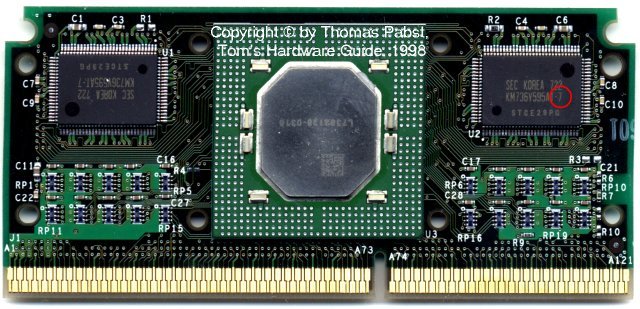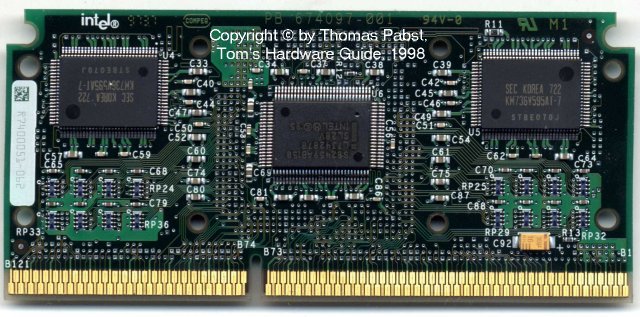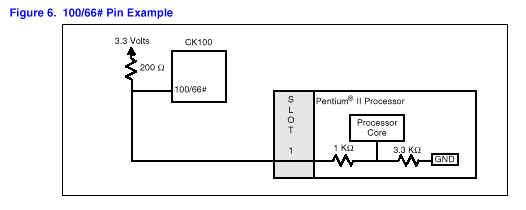Intel's Slot 1 CPUs Uncovered
Intel Pentium II 233 - 300 CPUs, Core Codename Klamath
Intel's first Pentium II CPU with the internal product specification number '80522 ' had the codename 'Klamath' and is still sold as the Pentium II versions 233 up to 300 MHz. It has got four second level cache modules with the speed marking of 7 ns and the tag RAM chip 82459AB . Due to the fact that it's only rated for speeds up to 150 MHz (300 MHz/2), the Klamath's second level cache timing is the fastest of all Pentium II CPUs, giving it a performance edge compared to Deschutes CPUs at the same clock speed, which of course is academical, since Deschutes starts at 333 MHz in a Pentium II. The Klamath core is larger than the core of the Deschutes, because it's still manufactured in .35 micron technology. This is also responsible for the larger heat production of the Klamath, compared to the Deschutes core. The common core voltage requirement of the Klamath is 2.8 V .
Many or most of the Klamath CPU's have the multiplier restricted, so that you cannot exceed the allowed core frequency as long as the front side bus frequency stays unchanged. Some 266 MHz CPUs can run at 300/66 however, so that some people specialized in counterfeiting the plastic package of a Pentium II 266, selling them as Pentium II 300 CPUs . Usually Pentium II 233 and 266 CPUs come without second level cache ECC and Pentium II 300 are pretty much all sold as second level cache ECC version. Thus c't-Magazine is asking every owner of a Pentium II 300 to check if their CPU is supplied with ECC level 2 cache, using a little program you can download from their website . If you have got a Pentium II 300 without ECC L2 cache you have most likely got a counterfeit Pentium II 266. This story is pretty valid, although I've once bought a Pentium II 266 in San Jose, that is not overclockable, but it has ECC L2 cache although it is only a 266 MHz version.
The Klamath is certainly overclockable, but in most cases it requires the increase of the front side bus frequency, which is dangerous for your PCI and AGP devices, because they run at PCI/AGP clocks above spec. Some crazy people overclock Pentium II 300 CPUs up to 375 MHz and even more. This is certainly an interesting thing to do, alas it is pretty useless for anyone who needs a reliable system. As a crazy overclocker you've got to live with the fact that your system can crash any time, if it's screwing up your presentation for the next morning or 'only' a Quake 2 rocket arena deathmatch. The L2 cache, in a Pentium II running at half of the core clock frequency and rated at 7 ns is absolutely not designed for clock speeds exceeding 150 MHz, maybe it will do 166 MHz in some cases, but don't expect any reliability of a 7 ns L2 cache running at 175 MHz or even more.
The package of the Klamath core itself shows that the chip hidden under the octagonal metal cover is larger than a Deschutes.
Please note the four second level cache modules, rated 7 ns and the tag RAM chip on the opposite side of the CPU, saying '82459AB'. You will not find the resistors that differentiate a 66 from a 100 MHz front side bus CPU. The Klamath is only rated for 66 MHz FSB and thus the PCB has the FSB detect Pin 'B21' hardwired to 0 V. Intel Pentium II 333 - 400, Core Codename Deschutes .
Intel managed shrinking the core of their 6th generation MMX CPU to 0.25 after the Klamath was on the market for roughly 8 months. This resulted in higher core frequencies, lower voltage requirements and less heat production. However, higher core speeds mean higher second level speeds as well, so that Intel needed to change the modules for the second level cache as well as its timing. The new L2 cache modules are packed at a higher density, so that only two modules are required. These new modules are rated 5.5 ns for 333 and 350 MHz Pentium II CPUs and 5 ns for 400 MHz Pentium II CPUs . The tag RAM chip has changed as well, the 333 and 350 MHz Pentium II is using the newer 82459AC tag RAM, the 400 MHz version comes with the latest and fastest 82459AD chip.
The new generation of Pentium II CPUs is now running at 100 MHz front side bus, whilst the Klamath as well as the Deschutes at 333 MHz are only supposed to run at 66 MHz FSB. Intel's BX chipset is able to recognize which kind of CPU is plugged into the motherboard, so that most BX motherboards are following the Intel spec and supply the correct front side bus frequency automatically. The detection of the correct FSB clock is done via CPU pin B21 , which is on low in case of a 66 MHz FSB CPU and high in case of 100 MHz FSB . In a Deschutes CPU the logical state of pin B21 is determined by two SMD resistors on the CPU PCB, R5 and R6 . In case of a Pentium II 333 these two resistors are 0 Ohm , in case of a Pentium II 350 or 400 R5 is 1000 Ohm , R6 is 3,300 Ohm . (Literature: c't-Magazine, issue 8, page 177) This may be interesting for some very courageous people who want to solder the 1 kOhm and 3.3 kOhm resistors instead of the 0 Ohm ones onto the PCB.
Get Tom's Hardware's best news and in-depth reviews, straight to your inbox.
Current page: Intel Pentium II 233 - 300 CPUs, Core Codename Klamath
Next Page From The Intel Pentium II 350/400 Data Sheet

